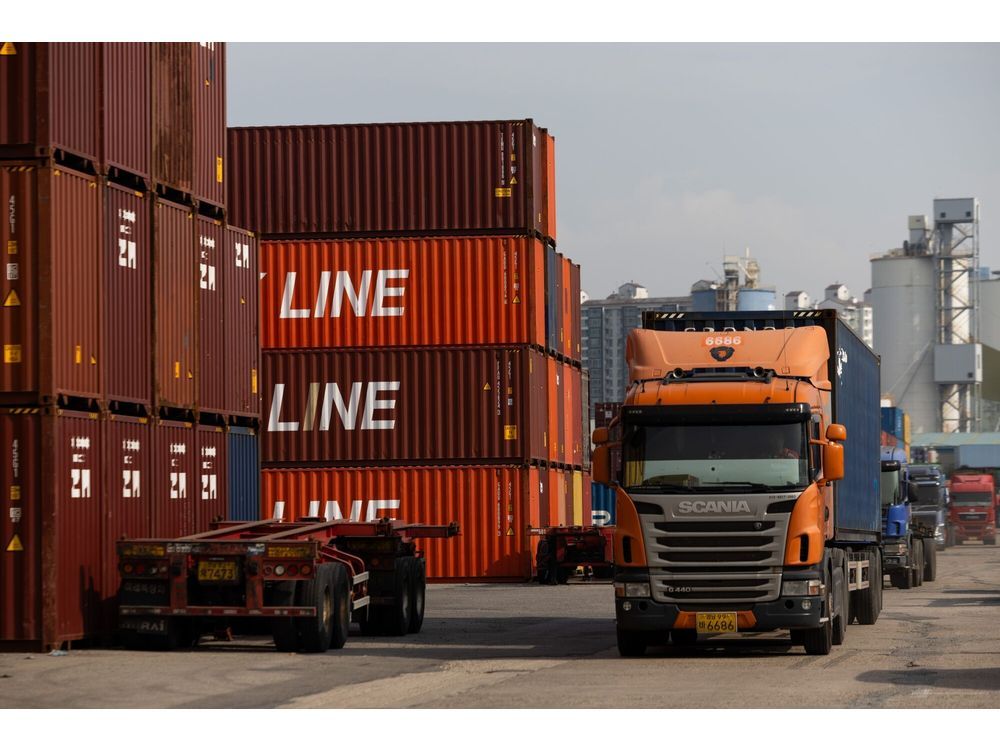
Article content
(Bloomberg) — South Korea’s export growth returned to a double-digit clip last month, an outcome that bodes well for the economic outlook and reflects the resilience of global demand for technology products.
Shipments that reflect working-day differences increased 13.7% from a year earlier, according to data released Sunday by the customs office. Without the adjustment, headline exports rose 11.4% while overall imports increased by 6%. The trade surplus came to $3.8 billion.
Article content
Exports are the leading engine of South Korea’s economic growth, with semiconductors, automobiles and refined oil products among key products that drive the overall performance. Authorities expect the nation’s economic growth to accelerate to the mid-2% range this year thanks in part to a resurgence in global trade.
In particular, a global frenzy for artificial intelligence development has been a boon for South Korean chipmakers including Samsung Electronics Co. and SK Hynix Inc.
Semiconductor exports rose 38.8% from a year earlier in August, according to Sunday’s data. South Korea accounts for the largest share of global memory-chip sales.
“A cyclical upswing in global semiconductor demand will help offset domestic sluggishness in Korea’s economy into next year,” Madhavi Bokil, senior vice president of strategy and research at Moody’s Ratings, said in a note before the data release. “We expect external demand for AI-related chips as well as US and EU-driven investment in new sectors such as EVs and renewable energy to offset domestic weakness and support a rebound in growth to 2.5% in 2024 and 2.3% in 2025.”
Article content
Demand has been led by major economies such as the US, where Nvidia has pioneered the development of AI chips, and where booming demand for electric vehicles has benefited South Korea’s automakers. China has also been a major buyer of the country’s electronics and chips.
The US has at times outweighed China as a source of demand for South Korean products since late last year, marking a turning point in Seoul’s relations with its two largest trading partners. South Korea has encouraged exporters to diversify their sales routes to reduce exposure to geopolitical risks stemming from simmering trade tensions between Washington and Beijing. China’s cloudy economic outlook creates another incentive.
“There are risks to increasing trade dependence on the United States, such as possible shocks to the financial, fiscal, and business environments,” Je Heon Kim, interim director at the Korea Economic Institute of America, said in a note. “South Korea must prepare and manage these risks by continuing to diversify its trade and supply chain.”
South Korea’s manufacturers are embedded across a wide array of global supply chains, and therefore their performance serves as a barometer of the vitality of world commerce. The country has been among the largest beneficiaries of a global trade resurgence this year, along with emerging nations including Brazil, Indonesia and Poland.
In contrast, exports from developed nations remain weak. That divergence is likely to continue in the second half of this year, according to Citigroup economists led by Cole Langlois.
South Korea’s export performance has been a factor deterring the central bank from making an early policy pivot. While the Federal Reserve is widely expected to start cutting interest rates this month, economists cautiously forecast the Bank of Korea will wait until next month or later to lower rates in a bid to address sluggish consumption.
Share this article in your social network